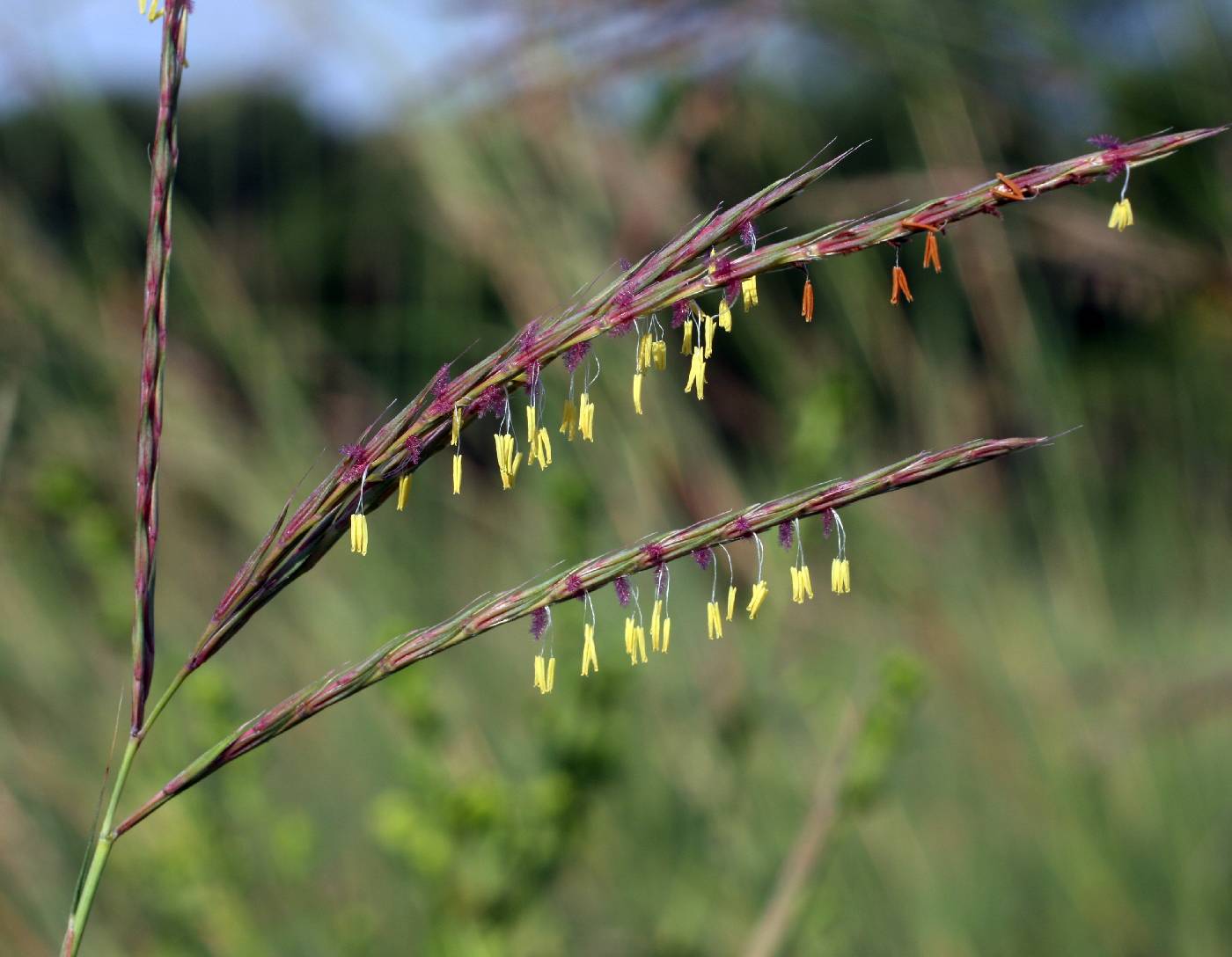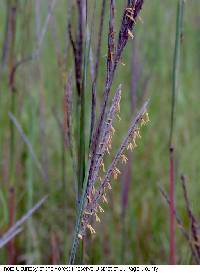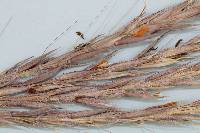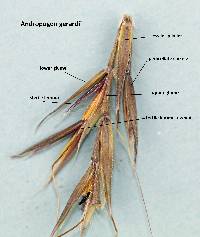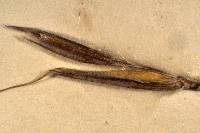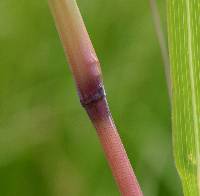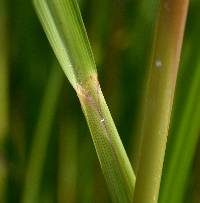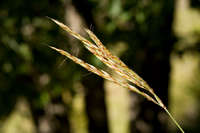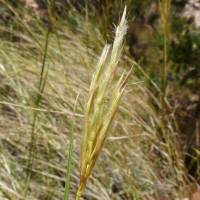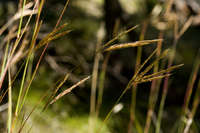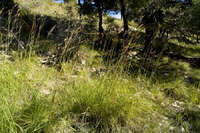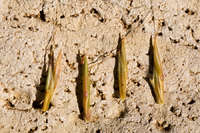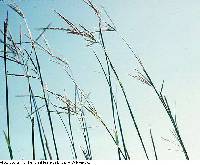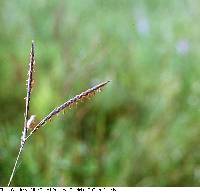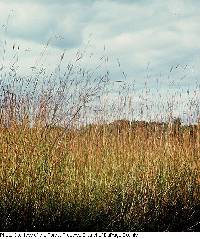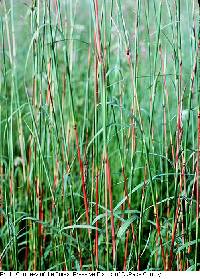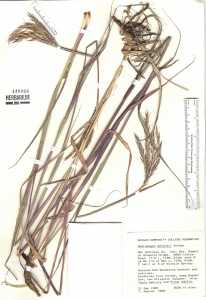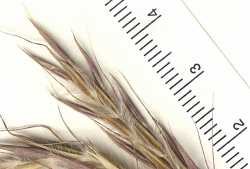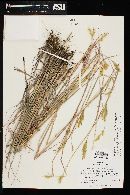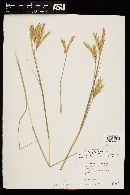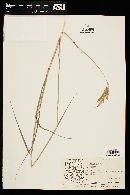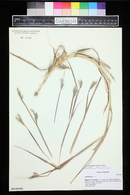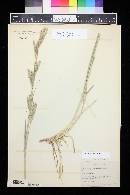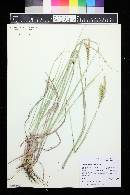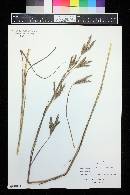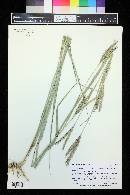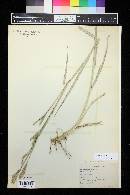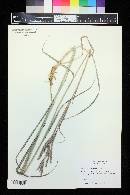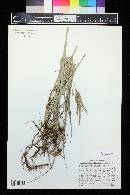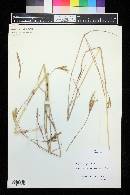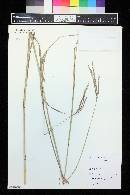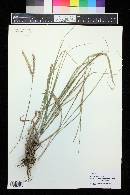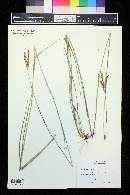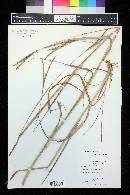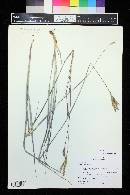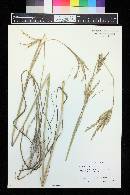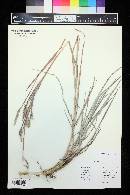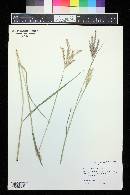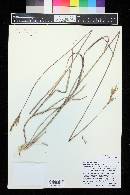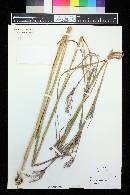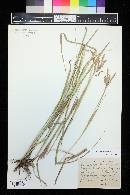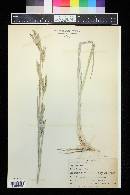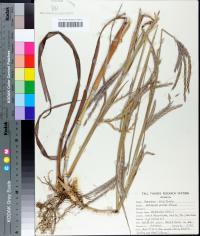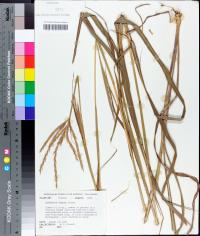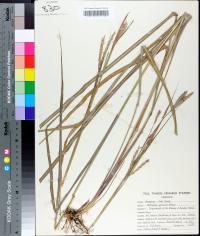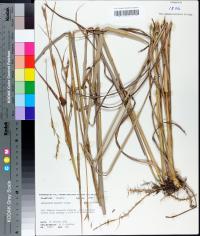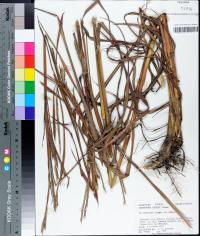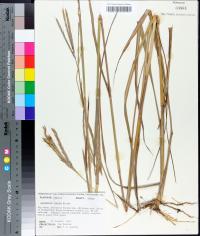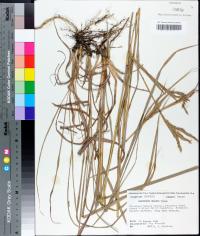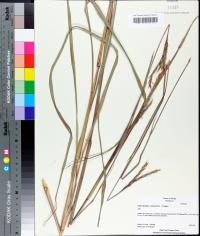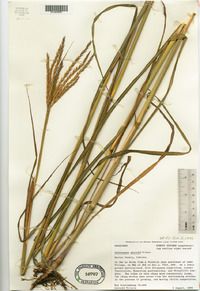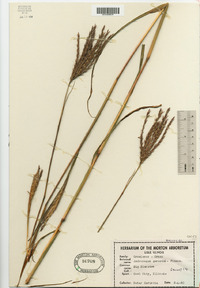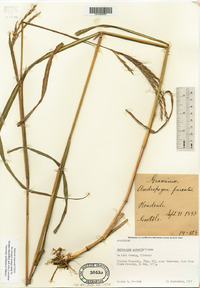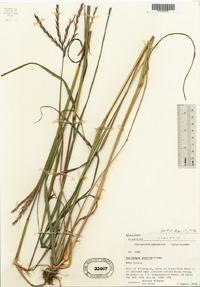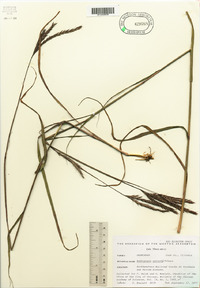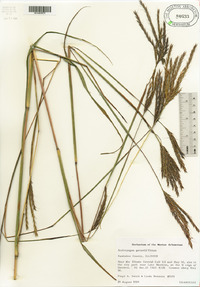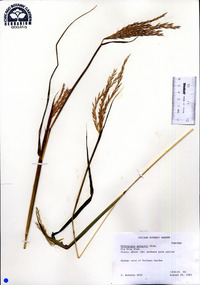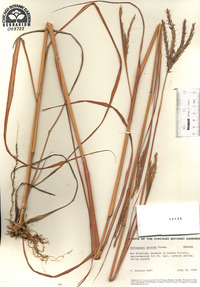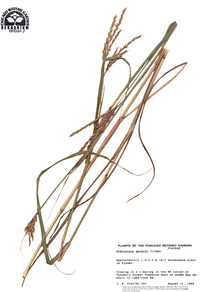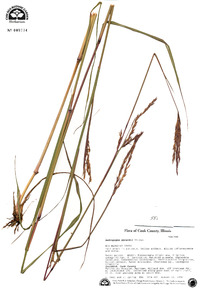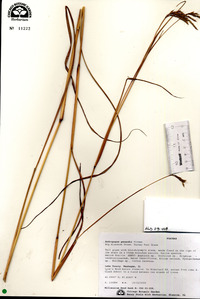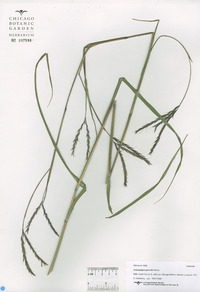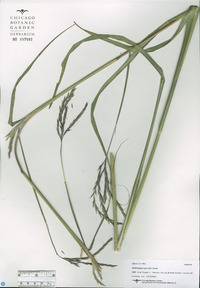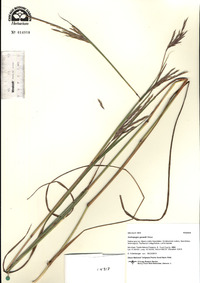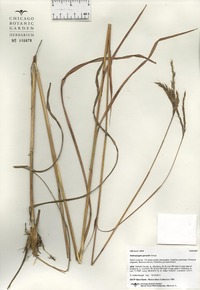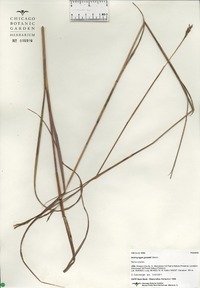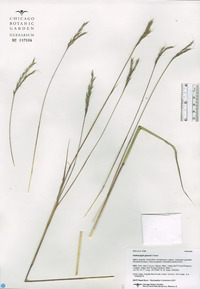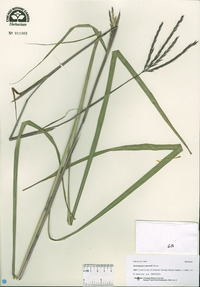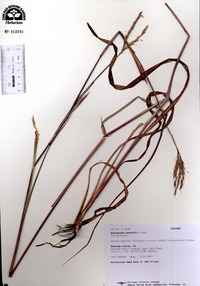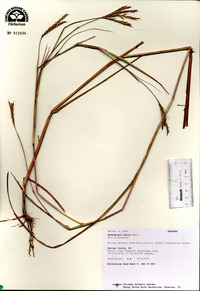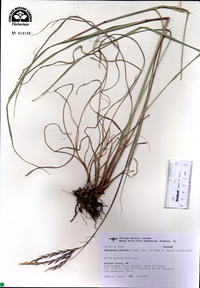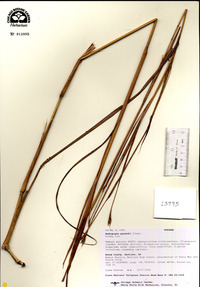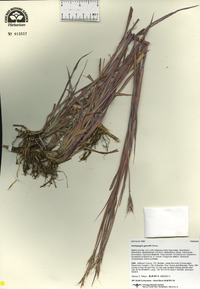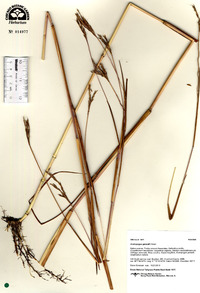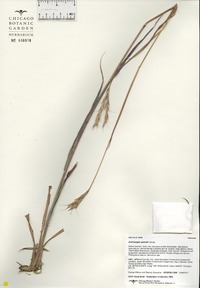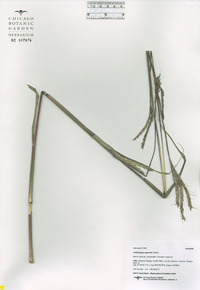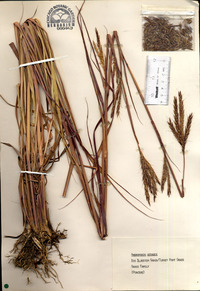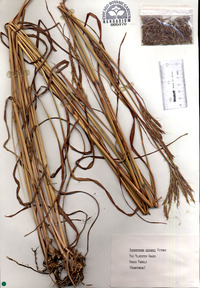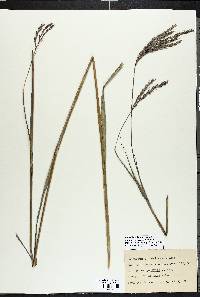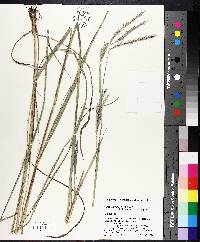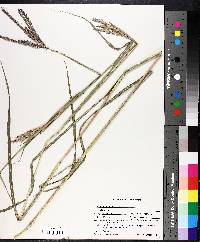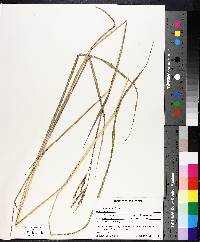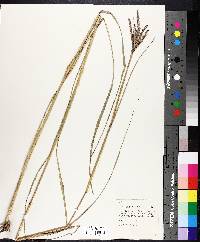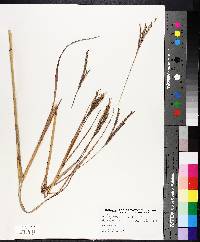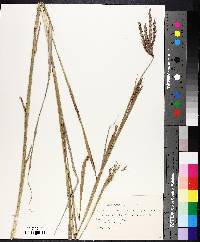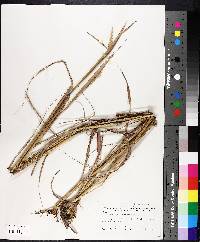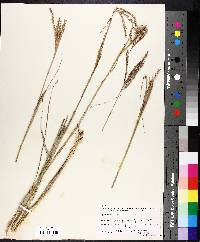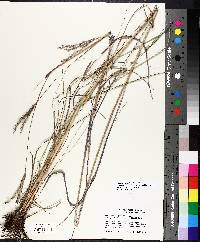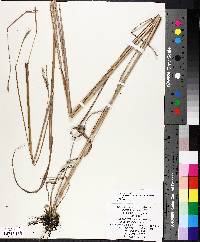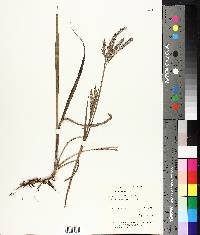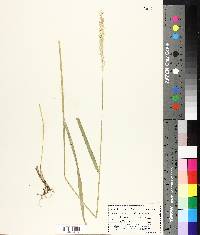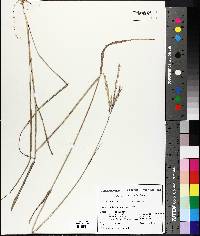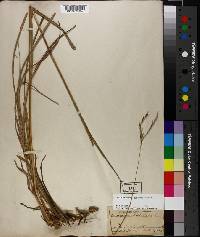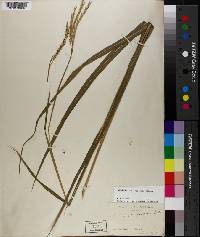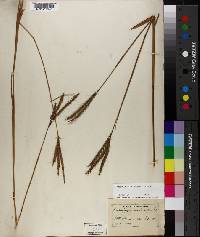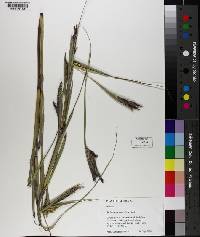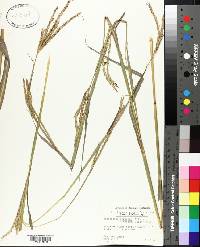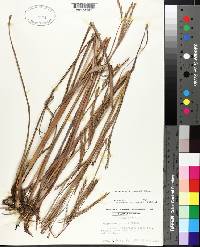
|
|
|
|
Family: Poaceae
Big Bluestem, more...bluejoint, turkeyfoot, Barbon de Gerard
[Andropogon chrysocomus Nash, moreAndropogon furcatus Muhl. ex Willd., Andropogon furcatus var. villosa Loew, Andropogon gerardi subsp. chrysocomus (Nash) Wipff, Andropogon gerardi var. gerardi , Andropogon gerardii Vitman, Andropogon gerardii subsp. gerardii , Andropogon gerardii var. chrysocomus (Nash) Fern., Andropogon gerardii var. gerardii , Andropogon hallii var. grandiflorus Scribn., Andropogon provincialis Lam., Andropogon provincialis var. tennesseensis Scribn., Andropogon tennesseensis (Scribn.) Scribn., Leptopogon furcatus (Muhl. ex Willd.) Roberty] |
Plants often forming large clumps, rhizomes, if present, with internodes shorter than 2 cm. Culms 1-3 m, often glaucous. Sheaths glabrous or pilose; ligules 0.4-2.5 mm; blades 5-50 cm long, (2)5-10 mm wide, usually pilose adaxially, at least near the collar. Inflorescence units usually only terminal; peduncles with 2-6(10) rames; rames 5-11 cm, exserted at maturity, usually purplish, sometimes yellowish; internodes sparsely to densely pubescent, hairs 2.2-4.2 mm, usually white, rarely yellowish. Sessile spikelets 5-11 mm, scabrous; awns 8-25 mm; anthers 3, 2.5-4.5 mm. Pedicellate spikelets 3.5-12 mm, usually well-developed and staminate. 2n = 20, 40, 60 (usually), 70, 80, 90. Andropogon gerardii grows in prairies, meadows, and generally dry soils. It is a widespread species, extending from southern Canada to Mexico, and was once dominant over much of its range. It is frequently planted for erosion control, restoration, or as an ornamental; the records from Washington and central Montana reflect such plantings. It hybridizes with A. hallii, the two sometimes being treated as conspecific subspecies. Dr. David Bogler, USDA NRCS PLANTS Database Perennials, Terrestrial, not aquatic, Rhizomes present, Rhizome short and compact, stems close, Stems nodes swollen or brittle, Stems erect or ascending, Stems geniculate, decumbent, or lax, sometimes rooting at nodes, Stems caespitose, tufted, or clustered, Stems terete, round in cross section, or polygonal, Stem internodes solid or spongy, Stems with inflorescence less than 1 m tall, Stems with inflorescence 1-2 m tall, Stems with inflorescence 2-6 m tall, Stems, culms, or scapes exceeding basal leaves, Leaves mostly basal, below middle of stem, Leaves mostly cauline, Leaves conspicuously 2-ranked, distichous, Leaves sheathing at base, Leaf sheath mostly open, or loose, Leaf sheath smooth, glabrous, Leaf sheath hairy, hispid or prickly, Leaf sheath and blade differentiated, Leaf blades linear, Leaf blades 2-10 mm wide, Leaf blades mostly flat, Leaf blade margins folded, involute, or conduplicate, Leaf blades mostly glabrous, Leaf blades more or less hairy, Leaf blades scabrous, roughened, or wrinkle d, Ligule present, Ligule an unfringed eciliate membrane, Ligule a fringed, ciliate, or lobed membrane, Inflorescence terminal, Inflorescence solitary, with 1 spike, fascicle, glomerule, head, or cluster per stem or culm, Inflorescence a panicle with narrowly racemose or spicate branches, Inflorescence a panicle with digitately arranged spicate branches, Inflorescence with 2-10 branches, Inflorescence branches paired or digitate at a single node, Inflorescence branches paired racemes, V-shaped, Flowers bisexual, Flowers unisexual, Spikelets pedicellate, Spikelets sessile or subsessile, Spikelets laterally compressed, Spikelet less than 3 mm wide, Spikelets with 2 florets, Spikelets paired at rachis nodes, Spikelets in paired units, 1 sessile, 1 pedicellate, Pedicellate spikelet well developed, staminate, Spikelets bisexual, Spikelets unisexual, Inflorescence disarticulating between nodes or joints of rachis, rachis fragmenting, Spikelets disarticulating below the glumes, Spi kelets falling with parts of disarticulating rachis or pedicel, Glumes present, empty bracts, Glumes 2 clearly present, Glumes equal or subequal, Glumes equal to or longer than adjacent lemma, Glumes keeled or winged, Glume surface hairy, villous or pilose, Lemmas thin, chartaceous, hyaline, cartilaginous, or membranous, Lemma 1 nerved, Lemma 3 nerved, Lemma glabrous, Lemma apex dentate, 2-fid, Lemma mucronate, very shortly beaked or awned, less than 1-2 mm, Lemma distinctly awned, more t Perennial herb forming large clumps, sometimes bearing rhizomes with internodes to 2 cm long 1 - 3.1 m tall Leaves: with hairless or soft-haired sheaths and 0.4 - 2.5 mm long, membranous ligules. The blades are 5 - 50 cm long, 2 - 10 mm wide, linear, and usually soft-haired on the upper surface (especially near the collar). Inflorescence: terminal, usually purplish but occasionally yellowish, with two to ten spikes 5 - 11 cm long, the internodes usually having white hairs 2.2 - 4.2 mm long. Fruit: a caryopsis. Culm: erect, highly branched above, 1 - 3 m long, usually covered with a whitish waxy coating (glaucous). Spikelets: either stalkless or stalked. The stalkless spikelets are bisexual, 5 - 11 mm long, and rough, and the stalked spikelets are male, 3.5 - 12 mm long, and well-developed. Glumes: minutely rough, often lined with hairs along the margins. The lower glume is thinly leather-like and has two longitudinal ridges that are usually winged. Florets: of the stalkless spikelets have a lemma with an awn 8 - 25 mm long and three anthers 2.5 - 4.5 mm long. Similar species: Andropogon virginicus is easily distinguished because its inflorescences are shorter than 5 cm, the stalked spikelets are absent or rudimentary, and the florets usually only have one anther. Andropogon hallii differs by having awns (if present) to 11 mm long, ligules 0.9 - 4.5 mm long, and rhizomes with internodes longer than 2 cm. Flowering: early July to late September Habitat and ecology: This species is common in moist and dry prairies and is often found along railroad tracks. It is usually the only surviving prairie species after a habitat has been destroyed. Occurence in the Chicago region: native Etymology: Andropogon comes from the Greek words aner, meaning man, and pogon, meaning beard. Gerardii is named after French botanist Louis Gerard (1733 - 1819). Author: The Morton Arboretum FNA 2007, Field Guide to Forest & Mtn Plants of N AZ 2009 Common Name: big bluestem Duration: Perennial Nativity: Native Lifeform: Graminoid General: Native perennial bunchgrass 0.5-3 meters tall with seedheads forming usually 3 spike-like racemes, a stem base that turns purple when it matures, occasionally rhizomatous. Vegetative: Often forms large clumps; rhizomes, when present, have internodes shorter than 2 cm long; stems often glaucous with slightly swollen, dark-colored nodes; ligules 1-2 mm; leaves are flat or sometimes folded, 5-50 cm long, 5-10 mm wide, usually with long ha Inflorescence: Inflorescence forms 2-6 (usually 3) branches 5-10 cm long, usually purplish but can be yellowish; internodes sparsely to densely pubescent with whitish hairs 2-4 mm long; spikelets in pairs, are 4-12 mm long, one is sessile and scabrous and the other is stalked and covered with fine hairs, both are gray-green to purplish with yellow to red anthers; awns 8-25 mm long. Ecology: Found in dry and sandy soils in prairies, plains, mesas, juniper woodlands, and ponderosa forests at 1200-2100 m (4000-7000 ft) in elevation, flowers July-September. Distribution: Found in all states east of Nevada and Idaho. Ethnobotany: Used for erosion control, habitiat restoration, and as an ornamental; is used for forage for livestock Etymology: Andropogon comes from the Greek andros, meaning man, and from pogon, meaning beard; in reference to the spikelets' hairs, resembling a man's beard. Synonyms: Andropogon chrysocomus, A. furcatus, A. gerardii var. chrysocomus, A. provincialis Editor: Lkearsley2012 Robust, tufted, sometimes shortly rhizomatous perennial 1-3 m, sometimes sod-forming, often glaucous; blades usually 5-10 mm wide, the lower ones and the sheaths sometimes villous; racemes (2)3-4(-6), 5-10 cm, subdigitate, on a long-exserted peduncle; joints of the rachis and pedicels equal, subterete, sparsely or usually densely ciliate, densely bearded at the top; spikelets appressed, 7-10 mm, the glumes minutely scaberulous, often ciliate; awn of the fertile lemma 8-20 mm, twisted below and ±bent; pedicellate spikelet staminate, about as large as the sessile one; 2n=20, 40, 60, 80-86. Moist or dry, open places, a major constituent of the tall-grass prairie; Que. to Sask., s. to Fla. and Ariz. (A. furcatus; A. provincialis) Gleason, Henry A. & Cronquist, Arthur J. 1991. Manual of vascular plants of northeastern United States and adjacent Canada. lxxv + 910 pp. ©The New York Botanical Garden. All rights reserved. Used by permission. From Flora of Indiana (1940) by Charles C. Deam Found sparingly throughout the state except in the prairie areas where it is common and where, before cultivation, it usually formed complete stands over all of the drier parts. This grass prefers a rather dry, sandy habitat but I have found it in hard, white clay soil in the Lower Wabash Bottoms and on rocky bars in streams. Outside the prairie area it is very erratic in its locations. ...... Indiana Coefficient of Conservatism: C = 5 Wetland Indicator Status: FACU Diagnostic Traits: To 3 m tall; spikes 2-6 in a +/- digitate cluster; pedicellate spikelets staminate, as large as the fertile spikelet; sessile spikelet >7 mm, its awn >5 mm long. |
|
|
|

